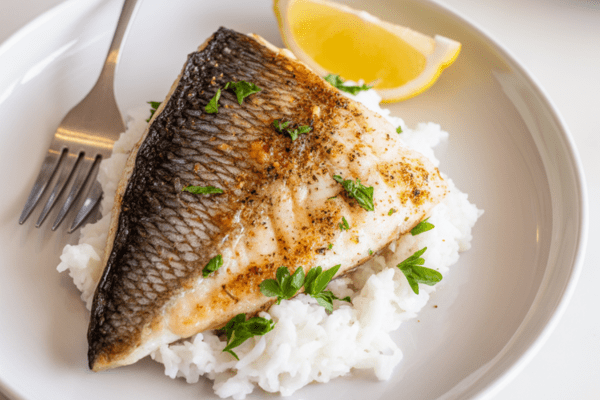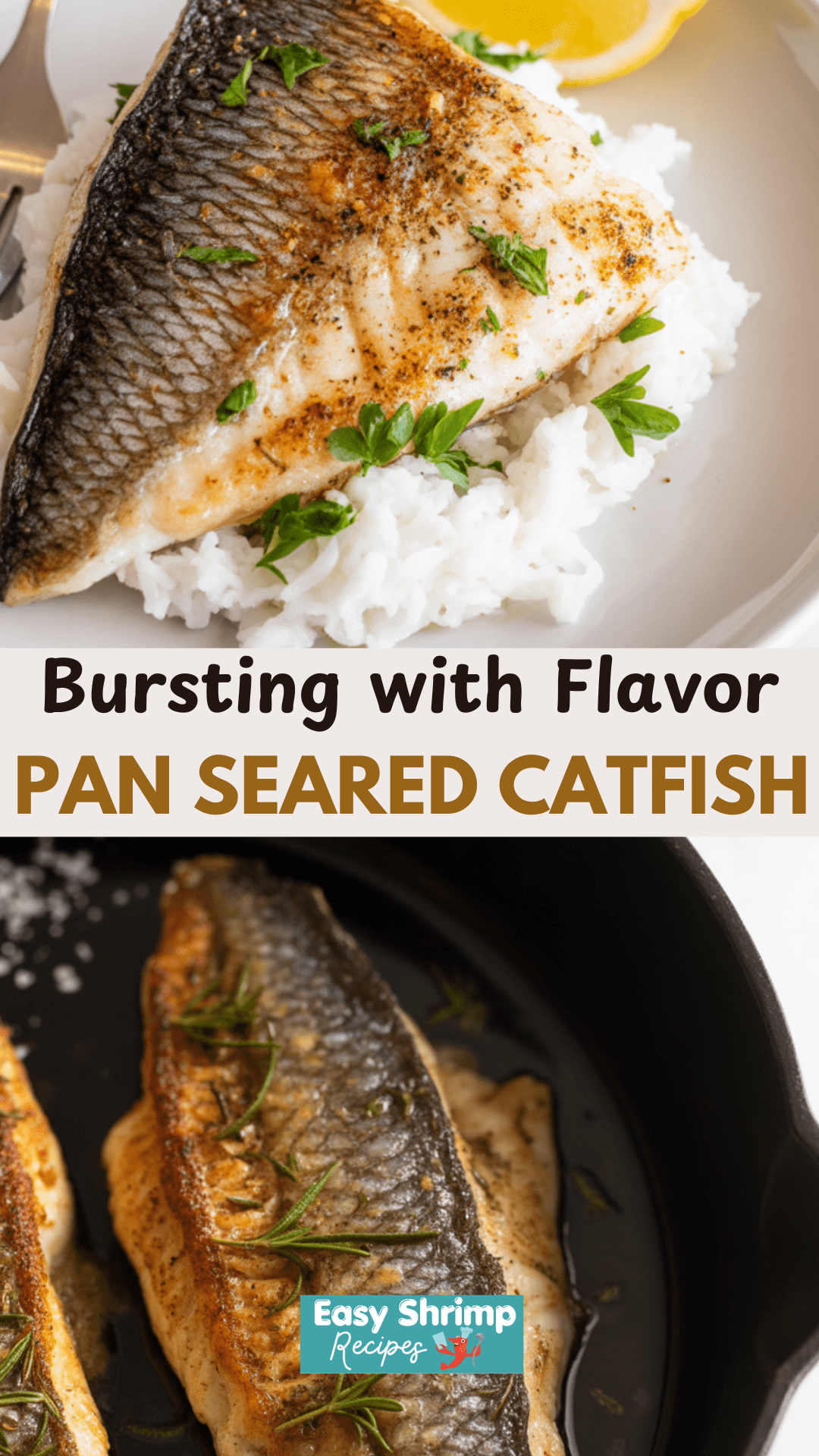If you’re looking for a no-fuss fish dinner that feels special but uses just a few simple ingredients, this pan-seared lemon herb catfish is one of my go-tos. It’s beautifully crisp on the outside, tender and flaky inside, and there’s no messy breading or deep-frying. Just honest, fresh flavors with a good squeeze of lemon.

I grew up with fish curries and fried fish in mustard oil, but pan-searing in butter and herbs has become one of my favorite ways to cook fresh fish at home. This recipe is especially meaningful for me because it brings back memories of trips to the local fish market with my dad, who taught me how to pick the freshest catch.
Why I Like to Cook Catfish This Way
Most catfish recipes I’ve seen over the years lean heavily on a cornmeal crust or batter, which is great if you want that Southern-style crunch. But some days I want something lighter that still gives me that golden, crisp exterior.
Pan-searing in a cast iron pan over medium heat does the trick. I love how it gives a subtle char while keeping the fish moist. It’s also a breeze to clean up after—less oil splatter than deep frying.
I usually get my fish from a trusted fish seller who knows what I like, but whenever I can, I choose local catch. I once got a really fresh catfish from a friend’s pond, and it completely changed my view of this humble fish. It was sweet, mild, and perfect for this pan-seared style.
If you have a cast iron pan, use it here—it really does make a difference. If not, a heavy-bottomed nonstick will do. The key is medium heat and patience. Let it sit without moving too much so you get that lovely sear.
My Go-To Ingredients and Why They Matter
You don’t need much to make this sing, but the few ingredients you use should be good quality. This is what I keep on hand for this dish:
- Catfish fillet: Fresh is best. Look for fillets that smell clean and feel firm. I sometimes swap in local river fish when I can’t get catfish, and it still works.
- Lemon: Fish and lemon are just meant to be. I use both zest and juice to really brighten things up.
- Dried thyme: This herb adds a gentle, earthy note that doesn’t overpower. I also sometimes use fresh if I have it in my little balcony garden.
- Olive oil: A light, neutral oil that helps prevent sticking and adds a subtle fruitiness. Avocado oil works well too.
- Butter: This is my secret for a rich finish. I use regular salted butter most days, but have made it with vegan butter for friends—it works beautifully.
- Salt and black pepper: Don’t skimp here. Season generously for the best flavor.
- Fresh parsley: I love the pop of green. It makes everything look fresher and more inviting.
I usually serve this over steamed rice with roasted veggies on the side. Sometimes I just go rustic with a hunk of crusty bread to mop up all the buttery, lemony juices.

A Few Personal Tips for Cooking It Right
- Preheat your pan well: If you’re using cast iron, give it a few minutes to get hot. It helps prevent sticking.
- Don’t overcrowd: Cook in batches if needed. Overcrowding cools the pan and you’ll lose that golden crust.
- Use fresh lemon: Bottled juice just doesn’t taste the same. A fresh lemon will give you zest and bright juice that makes the dish pop.
- Finish with butter: Swirl in butter at the end for a glossy, rich sauce. I learned this from watching chefs in old cooking shows on TV and it never fails.
- Rest before serving: Let the fish sit a minute off the heat. It finishes cooking gently and stays juicy.
How I Like to Serve It at Home
This dish is so versatile. On busy weeknights, I make it with plain rice and stir-fried beans or carrots. On weekends, I might get fancy and make a lemony risotto or buttery mashed potatoes.
When my cousins visit, I serve it family-style with lemon wedges all over the platter and big bowls of salad. It feels celebratory without much effort.
It’s also great in tacos—just flake it up, tuck it into warm tortillas, and top with a cabbage slaw. I did that once with leftover fillets and everyone asked for seconds.
Storing and Reheating
If you have leftovers (though we rarely do), let them cool completely and store in an airtight container in the fridge for up to 2 days.
To reheat, I use a nonstick pan over low heat with a splash of water or a bit more butter. It helps keep the fish moist without overcooking. I don’t recommend microwaving—it can make the fish rubbery.

Questions I Often Get About This Recipe
Can I use other fish?
Absolutely. This method works with tilapia, basa, or any firm white fish. I’ve even used small river fish fillets we get locally.
What if I don’t have cast iron?
A heavy nonstick pan works. Just avoid thin, cheap pans that heat unevenly.
Can I use fresh herbs?
Yes! Fresh thyme or dill is amazing here. Just add them at the end so they stay bright.
Cooking at home doesn’t have to be complicated. Sometimes all you need is a fresh piece of fish, a hot pan, and a good squeeze of lemon. I hope you give this pan-seared catfish a try—it’s a regular in my kitchen, and I think you’ll really enjoy it.
Pan Seared Catfish

Light, flaky, and full of bright flavor, this pan-seared catfish is a simple yet elegant way to enjoy a seafood dinner at home.
Ingredients
- 2 teaspoons dried thyme
- 1 tablespoon butter or ghee (vegan butter is fine)
- 2 tablespoons extra virgin olive oil
- 2 catfish fillets
- Juice from one lemon
- ¼ teaspoon black pepper
- ¼ teaspoon kosher salt
- Fresh parsley, chopped, for garnish
Instructions
- Place a large cast iron skillet over medium-high heat. Add the olive oil and butter, letting them melt and come together until the butter starts to sizzle.
- Meanwhile, pat the catfish fillets dry and season both sides with salt, pepper, and thyme.
- Gently lay the fillets into the hot skillet. Let them sear undisturbed for 2–3 minutes until golden on the bottom.
- Flip each fillet with a wide spatula. As the second side cooks, squeeze the juice of half a lemon over the fish. Let it cook for another 2–3 minutes, until the fish is cooked through and flakes easily with a fork.
- Transfer the fillets to plates. Add an extra squeeze of lemon juice if you like, and sprinkle with chopped parsley before serving.
Nutrition Information
Yield
2Serving Size
1Amount Per Serving Calories 513Total Fat 36gSaturated Fat 12gTrans Fat 0gUnsaturated Fat 22gCholesterol 126mgSodium 448mgCarbohydrates 21gFiber 2gSugar 15gProtein 27g
Easy Shrimp Recipes.com, occasionally offers nutritional information for recipes contained on this site. This information is provided as a courtesy and is an estimate only. This information comes from online calculators. Although allchickenrecipes.com attempts to provide accurate nutritional information, these figures are only estimates.

